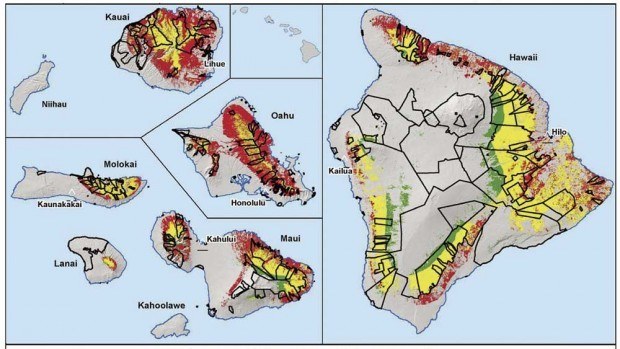The state Department of Agriculture has selected a site on the Big Island for an initial release of the tiny insect Tectococcus ovatus to help control the growth of strawberry guava. Native forests throughout the entire state, including Kaua‘i, are
The state Department of Agriculture has selected a site on the Big Island for an initial release of the tiny insect Tectococcus ovatus to help control the growth of strawberry guava.
Native forests throughout the entire state, including Kaua‘i, are threatened by the invasive plant, state officials say.
“This action needs to be taken,” DOA Chair Russell Kokubun said in a news release Tuesday. “The native forest cannot protect itself from invasive strawberry guava and while most people are not able to see how bad it is, survey maps show the massive damage the forests have already suffered due to this invasive plant.
“Saving the native forest ecosystem is far more important in terms of protecting unique resources for future generations,” he added.
Strawberry guava (Psidium cattleianum, Myrtaceae) is a native Brazilian plant that was introduced to Hawai‘i in 1825 and has since adversely affected Hawai‘i’s forests and watersheds. Mechanical removal is extremely difficult in remote forest areas, the release states.
“We hope that people understand that release of this biological control insect will not kill all strawberry guava,” said Tracy Johnson, lead researcher for the U.S. Forest Service in Hilo. “There will still be a lot of strawberry guava around. Slowing its reproduction and invasiveness will help restore the balance in favor of the native forest plants like ‘ohia.”
The T. ovatus presents an opportunity as a tiny scale insect that is also native to Brazil and lives most of its life inside of strawberry guava leaves. It creates leaf galls similar to the ‘ohia plants and reduces the vigor of the plant without killing it.
The U.S. Forest Service has been testing potential natural control insects for strawberry guava for more than 15 years and has determined that the T. ovatus would provide a natural control of the strawberry guava without harming other native or beneficial plants and insects.
The T. ovatus offers a natural control and makes the plant less invasive. The insect does not harm other plants, even the common guava, according to the DOA.
The U.S. Forest Service first presented the proposed release of the biocontrol insect in 2005. Opposition delayed the project and more outreach was emphasized the seriousness of the threat and to indicates the lack of a significant adverse impact.
Hawai’i researchers have had success with introducing 51 biological control of plant pests and diseases since 1975, the release states. Without any unintended adverse effects, the targeted weeds include clidemia (Koster’s curse), banana poka, ivy gourd, panini cactus have all been impacted.
These previously invasive plants can still be found in Hawai‘i, but naturally controlled at a level where they are not invasive. Biological control has also been successfully used to save the native wiliwili trees from the erythrina gall wasp and to control the stinging nettle caterpillar, the release states.
The full environmental assessment may be found at the OEQC website at http://hawaii.gov/health/environmental/oeqc/index.html.


